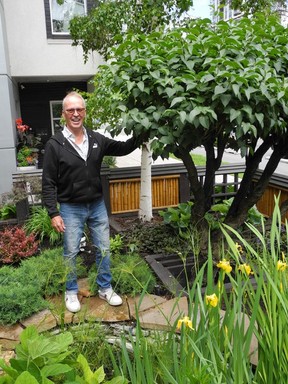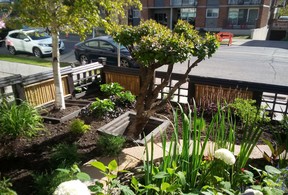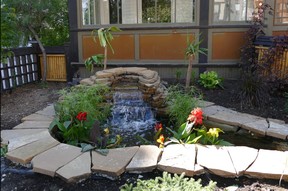Brooks: Inner-city garden grows along with the neighbourhood

Reviews and recommendations are unbiased and products are independently selected. Postmedia may earn an affiliate commission from purchases made through links on this page.
Article content
Some people have an innate ability to create things we admire. Whether art, literature, music, decor, cuisine, fashion or landscaping, we all benefit from their enviable skill.
Advertisement 2
Article content
Peter Taylor, the founder of 11th Street Gardens Inc., is a gardener-landscaper with an eye and feel for all things green. Taylor grew up in rural Ontario, which perhaps explains his connection to Mother Nature. Yet, it wasn’t until 1995, when he and his partner John purchased a pair of two-storey, side-by-side houses built in 1912, that Taylor was bitten by the gardening bug.
The houses, not to mention the yard, had been neglected for quite some time, yet their inner-city location proved ideal as rental properties. In short order, the couple had 15 tenants, fully occupying both houses. The next year, improvements were underway with the largest undertaking being the construction of a small sandstone pond with a waterfall, fencing and decking area for tenant enjoyment.
Advertisement 3
Article content
Sadly, the enjoyment was short-lived thanks to a late-night speeding car careening through the fence and lodging firmly in the pond, destroying the waterfall. Fate, or provenance, created the opportunity to start over. More than four truckloads of soil rich in mushroom compost, a new Asian-inspired fence, a waterfall spilling into a large pond spanning the width of both yards, careful and studied selection of various perennials, and heaps of TLC for a sickly birch and aged lilac transformed the landscape into an oasis.

The tree-lilac, Taylor says, could be as old as the houses. Lilacs of that variety are well known to survive 100-plus years. The older branches and trunk began twisting in the years following severe pruning and shaping. Initially, lilac suckers covered nearly 70 per cent of the front lawn. Before installing the new raised garden and pathways, the entire area was covered with layers of commercial-grade landscape fabric to stop the prolific suckers. What Taylor discovered within the first three years was that the tree-lilac sets its blooming buds a full year before blooming time. When a lilac is substantially pruned any time of year, the tree does not produce blossoms for at least another year, but usually two full seasons.
Advertisement 4
Article content
Scores of people walk the street daily, so it’s not surprising that within a short period, Taylor was hired to construct water features and create luscious landscapes at four other properties.

Fate interceded yet again when Taylor connected with the late Harold Hanen in 1997 and the two worked together for three years until Hanen’s passing. Hanen, a renowned architect and urban designer, is most notably remembered for developing Calgary’s Plus-15 walkway system, the most extensive and above-ground pedestrian network in the world. Taylor honed his skills and knowledge with Hanen’s influence. Learning by doing is another way Taylor expanded his green skills. That and “watching gardening shows and reading gardening books and magazines” he confesses.
Advertisement 5
Article content
In 1998, Taylor’s 11th Street Gardens Inc. really took off and he has designed, created and constructed numerous projects since then in inner-city Calgary, Springbank, Elbow Valley and Banff.
Taylor and his partner John have lived in one of the two houses for several years now, while the other is a popular, four-unit B&B aptly named 11th Street Lodging B&B.

Taylor’s Tips
• Gardens with myriad perennials create visual interest. Some to consider using are hosta, bugleweed, heuchera, bugloss, angel wings, various grasses, specimen Japanese maple, Annabelle hydrangea, King Tut papyrus, heliopsis and rattlebox.
• Taylor uses fertilizer with a higher nitrogen content early in the spring and fish fertilizer for the remainder of the gardening season.
Advertisement 6
Article content
• The pond is not drained before winter as the frozen water shores up the pond’s edges. The pump is removed before the water freezes.
• Taylor makes sure not to dig too deeply at the base of his birch tree as birch roots are finicky and don’t like to be disturbed.
• He frequently purchases new and interesting varieties of annual seeds from catalogues. The seeds are sown in a friend’s greenhouse outside of the city and then transplanted into window boxes, containers and so on after the appropriate number of weeks. “It’s like having my own private grower”, he says.
• When purchasing perennials from big box stores or garden centres, make sure to buy only zone-appropriate plant material. Calgary is Zone 3. You can get away with perennials hardy to Zone 4 if you have micro-climate conditions, maybe even Zone 5, but that’s pushing it.
• The three most important factors that will determine success or failure are light, exposure and moisture.

